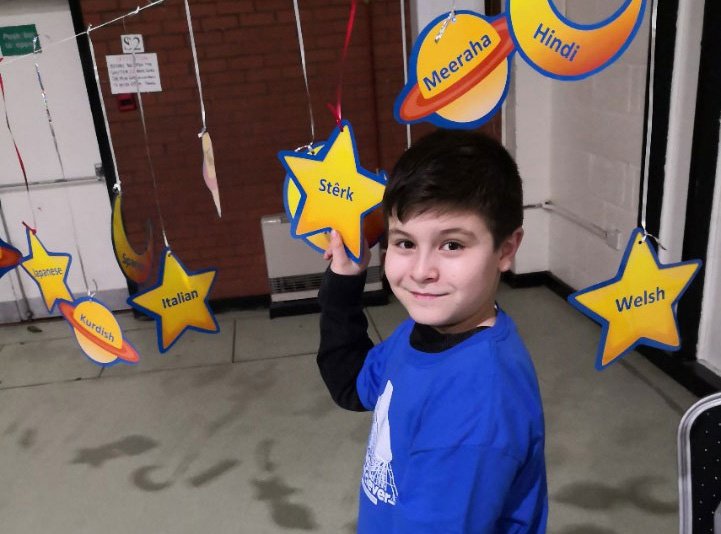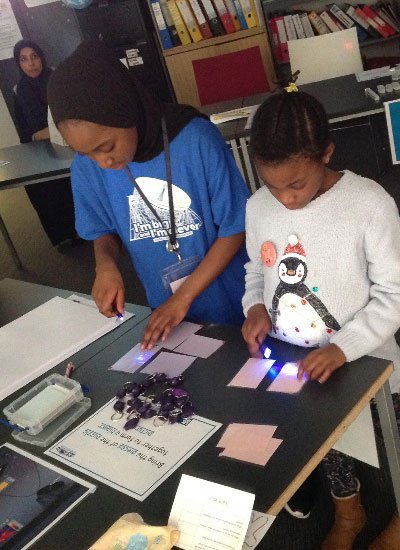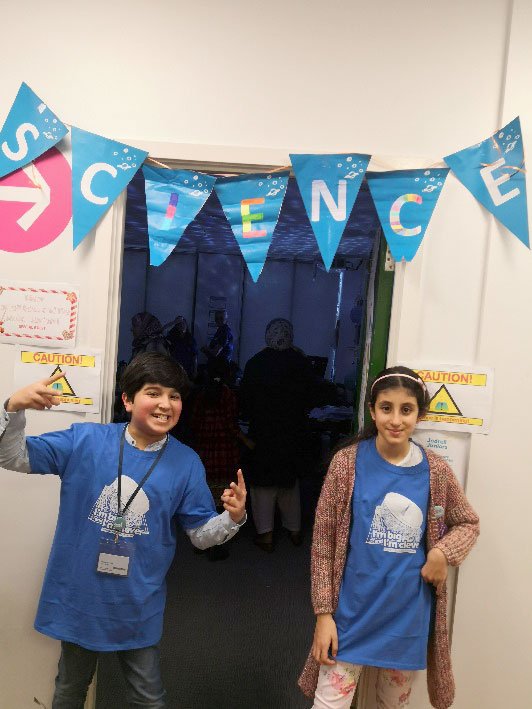The Jodrell Juniors from Stanley Grove Primary Academy
Jodrell Bank Discovery Centre worked with Stanley Grove Primary Academy.
Who did you work with?
We worked with Stanley Grove Primary Academy (SGPA). The school is in Longsight, an area of high socio-economic deprivation in Manchester. The school has previously visited Jodrell Bank and we have also worked with them through their 'Building the Bridge' project, which is designed to tackle poverty of experience amongst the school’s pupils.
Had you worked together before?
SGPA had previously visited Jodrell to participate in our education programme. The relationship developed further in 2016 when the school invited us to bring an outreach stand to their biannual community festivals for which the school is the hub. The festivals are part of SGPA’s ‘Building the Bridge’ project, the result of Experiential Audits conducted with families through which it was discovered that the pupils and community were very isolated and not accessing facilities/resources which many of us take for granted – a ‘poverty of experience’. Since studies show that children have better life chances the more they do as a family and the more they visit and take part in cultural events, the school have linked with partners to address this deficit, creating community festivals which provide the opportunity for families to engage with partner organisations and ‘build a bridge’ to engaging independently.
The festivals have a strong community focus that extends well beyond the school - approximately 2300 people from the local neighbourhood attended the summer ‘Bigger Book Bash’ festival; the central location for the winter ‘Let in the Stars’ event was Longsight Library. The festivals brought many outreach providers like ourselves to Longsight with the purpose of engaging with local families.

What goals, values or priorities did you share with your partner?
The school were keen to expand the horizons of their pupils and encourage members of the local community to take advantage of the resources available within their region- to address the ‘poverty of experience’ revealed by their audit. From our side, our starting point was an aim to build awareness of Jodrell Bank amongst the community where the festivals are based, who were not an audience who visited Jodrell at that time. Longsight is a culturally diverse area of Manchester and although JBDC’s schools programme reaches a diverse audience, representative of the UK population as a whole, this diversity did not extend to JBDC’s current general visitors. The timing of the EYU4 project was fortuitous, happening to coincide with a period over which the school were looking to develop their science curriculum and so the project presented an opportunity to add to their existing plans for curriculum development.
Can you summarise the aims of your project delivery in 2 (ish) sentences?
Having brought our own engagement and outreach to the community festivals with a JBDC stand over a number of years, the aim of this project was to engage with the community at a deeper level by supporting the Year 5 children at SGPA to create a science outreach stand of their own, and in so-doing to facilitate their ‘ownership’ of the science communication and the science itself. We aimed to increase the children’s confidence and nurture their interest in science, inspiring them to develop their interest further.

How co-produced was your programme?
- Information shared (the offer is decided and provided by you as the lead partner and people join to hear information)
- Consultation (the community partner/participants choose from a range of options, involving listening, feedback and discussion, but broader project objectives and delivery are led by you)
- Deciding together (community partners/participants support the creation and design phase, bringing new options and joint decision-making. Delivery and evaluation/reporting is led by you as the lead partner)
- Acting together (involvement of community partner/participant at each stage - from the planning and design, to the delivery and evaluation – with shared decision-making that forms a partnership to carry out the full programme)
- Supporting independent community interest (supporting partner agency, including offered funding, advice, and support to develop the independent ideas and agendas of the community partner).
Can you note down some of the benefits and challenges to working this way?
Like many schools, SGPA is the hub of the local community and a place around which a lot of community life revolves. Through working with the school over a number of years we have developed our relationship with the local community, slowly becoming more known by the children and their families. In terms of the EYU4 project, the school were able to help and advise us about how to achieve our aim – this included both the content and logistics of our plan. The logistics were challenging and we benefited enormously from their experience, being able to slot into an existing initiative they run – ‘Creative Crew’ – through which children apply to participate in a particular project. This meant that their time with us was already built into the school timetable.
Involving the children in decision making about content was challenging and at times progress was slow, however this approach was central to what we were trying to achieve ie that the children should have ownership of the engagement material. Thankfully the festivals’ Creative Director, Emma Martin, who was based at the school, was always on hand to advise us. We benefited hugely from Em’s expertise and her strong relationship with the children; her support and direction were invaluable. We learned so much from her about how to run this particular project but also how to conduct future work based around co-creation. Thank you so much Em and also to Judy Lyons from SGPA who were both an amazing support throughout the project!

What was the science link?
The engagement content of the outreach stand we developed with the children was STFC science and, specifically, the STFC science that related to the work taking place at Jodrell Bank Observatory ie a focus on astronomy and telescopes.
What happened?
The critical idea for the EYU4 project was that the children should be in the role of science communicators; hosting a stand at the community festivals, showing science demos and explaining the science to festival attendees. In order to prepare the children for this experience, the JBDC Engagement Team worked with 12 children in Year 5 (age 9-10 years) who became the ‘Jodrell Juniors’. We worked with the children over a number of months to enable them to explore, play with and learn about aspects of STFC science including light and lenses, ‘the invisible rainbow’ and stars and astronomy.
Jodrell Juniors hosted two events before the project was halted by the COVID-19 pandemic; the Winter Welcome (Dec 2019) and Multilanguage Mushaira (Feb 2020) community festivals in Longsight, Manchester.
At the ‘Winter Welcome’ Jodrell Juniors demonstrated activities with light to festival-goers, explaining to friends and family how telescopes work and how we can detect ‘invisible’ light like infra-red, using various light sources, lenses and an IR camera.
The ‘Multi language Mushaira’ community event took place on 21st February, UNESCO Mother Language Day. Jodrell Juniors delivered a stargazing experience in our portable planetarium dome, sharing constellation stories from different cultures with friends and family. The Mushaira theme was ‘Home’ - during preparation sessions for the event the children (and JBDC team) talked about their own family heritage, using maps to show where our families come from. We learned ‘space’ vocabulary from around the world which we shared as a garland at the festival. We were joined by local poet Dom Conlon, who shared space-themed poetry under the night sky in the dome and encouraged festival-goers to share their own poems about space.
The elements of the project we were not able to carry out due to the pandemic were:
- a family day at Jodrell Bank, where the children visited Jodrell with their families. The intention was for the children to take turns running an engagement stand over the day
- an INSET day session where the children engaged their teachers with the STFC science, supported by the Jodrell Engagement team
What challenges might lie in wait for someone wanting to replicate this project?
The main challenge we experienced was time – the process of first explaining the science and then involving the children to think about how to explain it to others took longer than we originally anticipated, and we realised that our original plan was too ambitious, certainly too ambitious to achieve in the time available.
Although we worked with the children for 2 hours at a time – significant in the school daily timetable – the gaps between our sessions with them meant that it took a while to ‘get into’ the science again, and of course it also took time for us and the children to get to know each other. When it came to offering the children choice about what to include amongst the outreach activities, we were guided by Em to provide structure to the options available to help the children make a choice and to avoid the risk of ‘stalemate’ due to lack of consensus. With Em’s support we were thus able to maintain the ‘ownership’ element, central to our project aim, whilst continuing to move the project forward.
Where there any surprises?
The original plan was based around the children taking ownership of the science, with the aim of furthering their interest and passion for science and aspirations about becoming a scientist. However, as the sessions progressed, it became evident that the skills around the communication of science and discussion about why effective science communication is important in society was also a significant theme. Unfortunately we didn’t have much time to explore this with the children as COVID-19 curtailed the project. However, the subsequent unfolding of the pandemic, with the numerous articles and beliefs around ‘fake science’ that occurred in the media has made this a topic that we would like to revisit in future.

How did you capture/measure the impact for this project?
Evaluation of the project mainly took the form of ‘reflection diaries’ completed by JBDC Engagement staff and journals completed by the children. Both of these were great for their ease and immediacy. In addition we had the benefit of external input from Jen DeWitt, who interviewed ourselves and Em from SGPA- this was invaluable in helping us think through our progress towards the project objectives. Throughout the project we were in communication with Em from SGPA who was an observer in our preparation sessions with the children and also supported our team planning, giving feedback and guidance throughout.
Where is the long-lasting change?
As a team we learned a lot about co-creation through this project. It was wonderful to have the freedom to explore how to work with one small group in a meaningful way, rather than be aiming to reach a huge audience for more transient engagement - we now have a more realistic idea of how much time co-creation requires to work well and have begun to have a sense of how much to direct the progress of the project and how much to leave open to the participants’ choice. The model we developed- supporting the children to take ownership of the science and of its communication - is one which we intend to revisit. It was exciting to hear the children explaining and demonstrating science to their families and friends who sought them out at the festivals – and tantalising that we had this glimpse that the project was working out as intended before it came to an abrupt halt with the pandemic.
